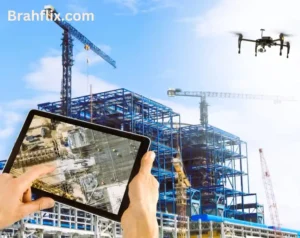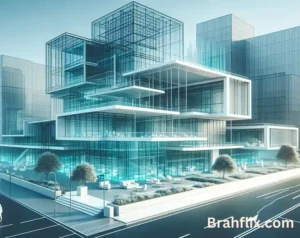Introduction
In recent years, technology has dramatically reshaped various sectors, and the construction industry is no exception. From 3D printing to smart building technologies, advancements have revolutionized modern building practices, making them more efficient, sustainable, and innovative. This article delves into the impact of technology on modern building practices, highlighting how these advancements are transforming the way we design, construct, and manage buildings.
Key Takeaways
- Enhanced Efficiency: Technology streamlines construction processes, reducing time and labor costs.
- Improved Accuracy: Advanced tools and techniques lead to greater precision in building design and execution.
- Increased Sustainability: Green technologies and smart systems contribute to more sustainable building practices.
- Innovative Materials: New materials and construction methods are revolutionizing building design and functionality.
- Better Project Management: Technology facilitates better planning, monitoring, and management of construction projects.
- Enhanced Safety: Technological advancements improve safety protocols and reduce risks on construction sites.
1. Streamlining Construction Processes with Technology
One of the most profound impacts of technology on modern building practices is its ability to streamline construction processes. Innovations in construction technology have led to faster and more cost-effective building methods.
The Role of Building Information Modeling (BIM)
Building Information Modeling (BIM) has revolutionized how construction projects are planned and executed. BIM allows for the creation of detailed 3D models of buildings, providing a comprehensive view of the project from design through construction. According to a 2023 McKinsey report, BIM adoption can reduce project time by up to 30% and costs by 20%.
Automation and Robotics in Construction
The integration of automation and robotics in construction has further streamlined processes. Robots can handle repetitive tasks such as bricklaying and concrete pouring with high precision, reducing the need for manual labor and minimizing errors. For instance, the Hadrian X, a bricklaying robot, can lay up to 1,000 bricks per hour, a significant increase over human laborers.
Prefabrication and Modular Construction
Prefabrication and modular construction involve assembling building components off-site before transporting them to the construction site. This method not only speeds up the construction process but also enhances quality control. Modular construction can cut project timelines by up to 50% compared to traditional methods.
2. Precision and Accuracy in Building Design
Advancements in technology have significantly improved precision and accuracy in building design. High-tech tools and techniques ensure that construction projects meet exact specifications, leading to better outcomes and fewer mistakes.
Laser Scanning and 3D Printing
Laser scanning and 3D printing are two technologies that have enhanced design accuracy. Laser scanners create detailed 3D maps of existing structures, allowing for precise measurements and adjustments. 3D printing, on the other hand, enables the creation of accurate prototypes and even actual building components, reducing design discrepancies and errors.
Virtual Reality (VR) and Augmented Reality (AR)
Virtual Reality (VR) and Augmented Reality (AR) are transforming how architects and builders visualize and interact with building designs. VR allows for immersive walkthroughs of virtual models, while AR overlays digital information onto physical spaces. These technologies help identify potential issues early in the design process, ensuring more accurate and effective solutions.
3. Promoting Sustainability in Modern Building Practices
Sustainability has become a major focus in modern building practices, and technology plays a crucial role in promoting eco-friendly construction methods.
Green Building Technologies
Green building technologies are designed to minimize environmental impact and enhance energy efficiency. Technologies such as solar panels, green roofs, and energy-efficient HVAC systems contribute to sustainable building practices. According to the U.S. Green Building Council, buildings certified under the LEED (Leadership in Energy and Environmental Design) program use 25% less energy and 11% less water compared to conventional buildings.
Smart Building Systems
Smart building systems use technology to optimize energy use and improve occupant comfort. Building automation systems (BAS) control lighting, heating, and cooling based on real-time data, reducing energy consumption and operational costs. The integration of Internet of Things (IoT) devices further enhances building efficiency by providing detailed insights into energy usage and system performance.
Sustainable Materials and Techniques
Technological advancements have led to the development of sustainable building materials and techniques. Recycled materials, low-VOC paints, and sustainable wood products are becoming more prevalent. These materials reduce the environmental impact of construction and contribute to healthier indoor environments.
4. Innovating with New Materials and Construction Methods
Innovative materials and construction methods are redefining what is possible in building design and construction. These advancements allow for more flexible, efficient, and visually striking buildings.
High-Performance Materials
High-performance materials, such as self-healing concrete and lightweight composites, offer enhanced durability and functionality. Self-healing concrete contains bacteria that produce limestone to fill cracks, extending the lifespan of structures. Lightweight composites reduce the weight of building components without compromising strength.
Advanced Construction Techniques
Advanced construction techniques such as 3D printing of buildings and robot-assisted construction are pushing the boundaries of traditional building methods. 3D printing allows for the creation of complex structures with minimal waste, while robot-assisted techniques enable precise construction of intricate designs.
Examples of Innovative Projects
- The Edge, Amsterdam: This smart office building incorporates advanced technologies such as automated lighting and climate control systems.
- The Burj Khalifa, Dubai: Utilizing high-performance materials and innovative construction techniques, the Burj Khalifa remains the tallest building in the world.
5. Enhancing Project Management with Technology
Technology has significantly improved project management in the construction industry. Advanced tools and software enable better planning, execution, and monitoring of construction projects.
Project Management Software
Project management software such as Procore and PlanGrid streamline the management of construction projects. These platforms offer features like real-time collaboration, document management, and progress tracking, helping project managers stay organized and ensure timely completion.
Drones for Site Inspection
Drones are increasingly used for site inspections and progress monitoring. Equipped with high-resolution cameras, drones provide aerial views of construction sites, enabling project managers to track progress, identify issues, and ensure compliance with design specifications.
Data Analytics for Improved Decision-Making
Data analytics plays a crucial role in project management by providing valuable insights into project performance. Analyzing data related to costs, timelines, and resource allocation helps project managers make informed decisions and optimize project outcomes.
6. Improving Safety on Construction Sites
Safety is a top priority in the construction industry, and technology plays a key role in enhancing safety protocols and reducing risks on construction sites.
Wearable Technology for Safety Monitoring
Wearable technology such as smart helmets and vests equipped with sensors helps monitor the health and safety of construction workers. These devices can detect hazardous conditions, track workers’ vital signs, and provide real-time alerts in case of emergencies.
Safety Management Software
Safety management software helps manage and track safety protocols, incidents, and compliance. Platforms like eCompliance and Safesite offer tools for reporting safety hazards, conducting inspections, and managing safety training programs.
Robotics for Hazardous Tasks
Robotics can perform hazardous tasks, such as handling heavy materials or working in dangerous environments, reducing the risk of injuries to human workers. For example, robots equipped with advanced sensors can safely operate in high-risk areas like construction sites with unstable structures.
FAQs
1. How has Building Information Modeling (BIM) improved construction projects?
BIM provides a detailed 3D model of buildings, improving accuracy in design and construction, reducing project time and costs, and facilitating better collaboration among project stakeholders.
2. What are some examples of green building technologies?
Examples include solar panels, energy-efficient HVAC systems, green roofs, and water-saving fixtures. These technologies contribute to reduced environmental impact and lower operational costs.
3. How do smart building systems enhance energy efficiency?
Smart building systems use sensors and automation to optimize energy use for lighting, heating, and cooling, based on real-time data, leading to reduced energy consumption and cost savings.
4. What role do drones play in modern construction?
Drones provide aerial views of construction sites for progress monitoring, site inspections, and data collection, helping project managers track progress, identify issues, and ensure design compliance.
5. How does technology improve safety on construction sites?
Technology improves safety through wearable devices that monitor workers’ health, safety management software that tracks protocols and incidents, and robotics that handle hazardous tasks.
Conclusion
The impact of technology on modern building practices is profound and far-reaching. From enhancing efficiency and accuracy to promoting sustainability and improving safety, technological advancements are reshaping the construction industry in significant ways. Embracing these innovations not only leads to better building practices but also contributes to a more sustainable and efficient future.
What technological advancements have you found most impactful in building practices? Share your thoughts and experiences in the comments below!
For further insights into how technology is transforming various industries, check out our other blogs. Discover more about the latest trends and innovations shaping the future of construction and beyond.
Explore more of our content to stay informed about the latest technological advancements and their impact on various industries.